
Report
Review of the Paris Special Operations Forces – Combat Medical Care Conference, Fall 2022.
Disclaimers:
The opinions or assertions contained herein are the private views of the authors and are not to be construed as official or as reflecting the views of the French and/or German military medical service.
Pierre Pasquier*1,2,3, Florent Josse*4,5, Pierre Mahé1
* These two authors contributed equally to the work
1 French SOF medical command, Villacoublay, France.
2 Department of anesthesiology and intensive care, Percy Military teaching hospital, Clamart, France.
3 École du Val-de-Grâce, French military medical academy, Paris, France.
4 Ulm Military hospital, Ulm, Germany.
5 Combat medical care – Conference scientific board, Germany.
Introduction
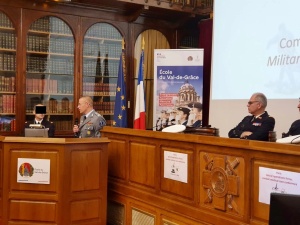
For the first time in Europe, the Paris Special Operations Forces - Combat Medical Care Conference, a satellite conference of the CMC-Conference in Ulm (Germany) took place on October 20-21, 2022, at the famous École du Val-de-Grâce in Paris (France), a historic and emblematic site for French military medicine (figure 1). The Paris SOF-CMC Conference was organized by the French SOF Medical Command and the CMC-Conference. Under the authority of COL Dr Pierre Mahé (French SOF medical command), the two scientific leaders of the conference (figure 2), COL Prof. Pierre Pasquier (France) and LTC Dr. Florent Josse (Germany), advanced a high scientific level around the medical support in the field of special operations. This international symposium was dedicated to military physicians and paramedics as also trauma and specialized surgeons, who are involved in the medical support of special operations. International medical experts provided updates on current scientific data. They also presented the points of view of their respective nations on the evolution of war medicine, during very high-level scientific sessions. The conference brought together nearly 300 participants (figure 3), speakers and industrial partners, from more than 30 countries (figure 4). This new Paris SOF-CMC Conference will be held every two years, alternately with the CMC-Conference in Ulm (Germany).
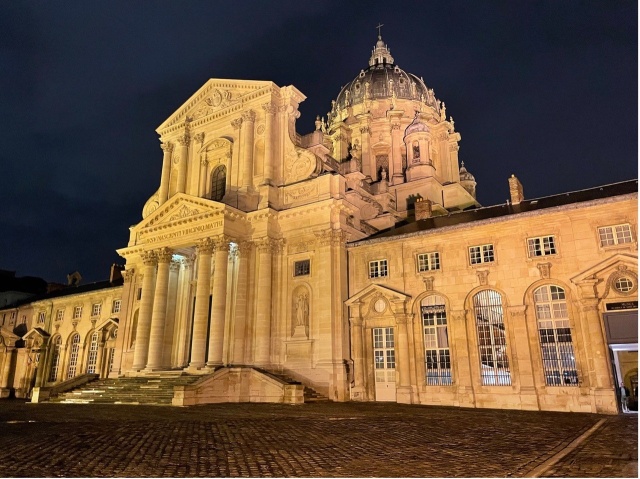
Opening lectures
The military authorities from the French SOF medical command, the SOF command, the École du Val-de-Grâce and the scientific leaders of the conference welcomed all speakers and attendees, described the history of special operations’ medical support, as well as its challenges in the modern warfare and discussed its changes in the future conflicts.
First session
This first session “Other bricks in the wall of SOF medical support” launched the conference with Initial medical response to massive casualty incidents in the SOF environment1 (Stacy Shackelford (Figure 5) Chief Joint Trauma System Defense Center of Excellence for Trauma, USA), then Prehospital blood transfusion in austere setting: from proof of concept to fine tuning2 (Sylvain Ausset, Head of French Military Health Schools, FRA), Transformational change in combat casualty care research for the SOF3 (Andrew P. Cap, Director of Research US Army Institute of Surgical Research, USA ) and the UK point of view for the future of SOF medical support4 (Tim Hodgetts, UK Surgeon General and Chair COMEDS, UK).
Session A
The first session featured “Airway management” and “Analgesia & sedation”. Topics were as varied and interesting as: Intubation and positive pressure ventilation in patients with hemorrhagic shock5, Surgical management of airway in SOF setting6, Analgesia and Sedation for Tactical Combat Casualty Care: TCCC Proposed Change 21-027, War-wounded analgesia8, and the Use of intranasal ketamine for prehospital analgesia in SOF: case series9.
The session “Damage control resuscitation and surgery in SOF environment” focused on Deployment of the Surgical Life-saving Module in 2017: lessons learned in setting up and training operational surgical units10; then the Belgian ruck for surgery11 and finally, the French aeromedical special operations forces – damage control resuscitation and surgery team.
After that the Session “Think & Do” highlighted the importance of the Human factors in critical situations12; the Mental training for stressful situations13 and also D-STRESS use of virtual reality to detect post-traumatic stress disorder14.
The “SOF physical constraints” session discussed the Havresac syndrome; the Medical support of high-altitude military parachuting15; Injuries in SOF airborne operations: a 5-years analysis and Basic nutritional considerations for SOF operators.
The last session pointed at “SOF combat casualties” with: treating Ukraine’s wounded civilians, I saw horror and hope16; Killed in Action (KIA): How Golden are 60 minutes?17; SOF casualties during counter-terrorism operations; and Ukrainian Report from the Field: TCCC in the multidomain battlespace18.
Session B
The “Bleeding session” discussed: The future of blood transfusion in austere setting19, Use of REBOA in the SOF setting20 and the Evaluation of hemostatic capacities among commando candidates: Would their blood suit a hemorrhagic war-injured patient in case of blood donation on the battlefield?21; and Fresh Whole Blood transfusion in Police Special Operations Teams: a perspective to reduce combat deaths in tactical austere environment in Brazil.
In the session “In the air”, experts in the field reviewed in-flight medicine with: In flight damage control resuscitation; In flight damage control surgery22; and In flight critical care during strategical aeromedical evacuation of SOF casualties23.
In the session “Special environment”, we learned about Heat stroke24; Medical support in (very) cold conditions; and the Medical support of prolonged subaquatic operations.
The sessions “Threats & hazards” pointed out: Cumulative blast exposure estimate model for SOF operators25; Prehospital Burns26; and the CBNR chain of survival and its mnemonic device “I AM THOR”, a new cognitive tool to teach initial measures in undertaking a CBRN event on the battlefield27.
The session “Prolonged field care” focused on: Point-of-care ultrasound for triage in austere military environments28; Prolonged Field Care Update29; and 20-year experience review of Tactical Medicine in SOF teams, in modern warfare inside Rio de Janeiro.
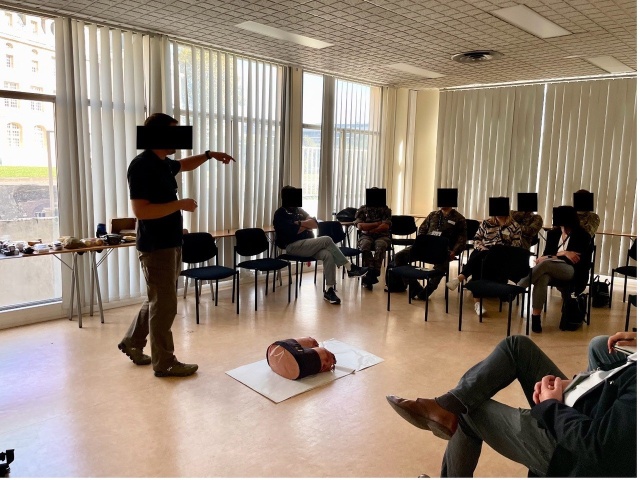
Workshops
Beside these two sessions A and B, the attendees joined multiple Workshops proposed by the French SOF Medical Command and the Industry:
- Trauma brain injury management. ZOLLÔ; Stop the bleed. SAM MEDICALÔ; Rapid Triage - wearable enhanced casualty monitoring. BLACK SPACE TECHNOLOGYÔ; Science behind Celox©. MEDTRADEÔ; High fidelity surgical simulation P4P “Pulse for Practice”. SIMEDYSÔ; Advanced medical post in high mobility conditions. UTILISÔ.
- How to prepare my backpack for subaquatic operations, for aiborne operations, for long pedestrian infiltrations; and a Tactical CBNR first aid kit.
- Tactical and Prolonged Field Care High Fidelity Simulation and Training Platform. TACMED SOLUTIONSÔ; Management patient in the battlefield. INMANIBUSMEISÔ; Prolonged field care or far forward resuscitation. PROMOTEQ ABÔ; EZIO intraosseous. TELEFLEXÔ; REBOA in an austere setting. PRYTIME MEDICALÔ; Innovative versatile compact warmers. CORBENÔ
- Demonstration of the French aeromedical SOF - damage control resuscitation and surgery team; Improvised ground evacuation of SOF casualties; Training and continuing education of French SOF nurses; Use of telemedicine for remote device.
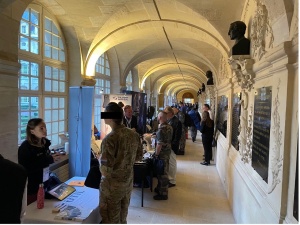
Industry exhibition
The 30 industry exhibitors of the demonstrated numerous different new and useful tools for medics, paramedics and physicians deployed in austere environments of special operations (figure 7).
Conclusion
Beyond the scientific interest, several major points were discussed in the light of recent warfare, with discussions enlightened by feedback from physicians and medics recently engaged in special operations. Thus, the participants and experts largely underlined the need to:
- be better prepared for the prolonged casualty care, in austere and remote settings, for several hours if not several days: the concept of “golden hour”, which has prevailed for the past 30 years, must now be complemented by that of “golden day”, which considerably modifies the skills and resources required for medical support of special operations;
- better prepare for, even ultra-, mass casualties incidents, using innovative technological solutions for triage;
- “Push the Role 2 into the Role 1!", raising a real challenge in the organization of SOF medical support, as well as in the training of SOF medical teams;
- continue research efforts on blood far forward programs, damage control resuscitation and surgery.
In all these areas, disruptive solutions in terms of doctrine, procedures and equipment are being developed and will feed future thinking.
A new edition of the Paris SOF-CMC Conference is already planned for 2024, after the CMC-Conference in Ulm (Germany) on July 5-6, 2023.30
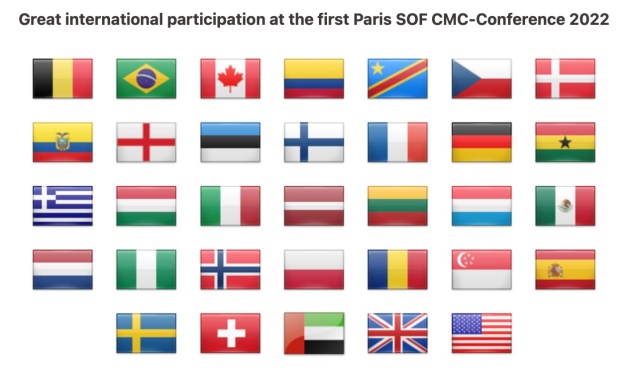
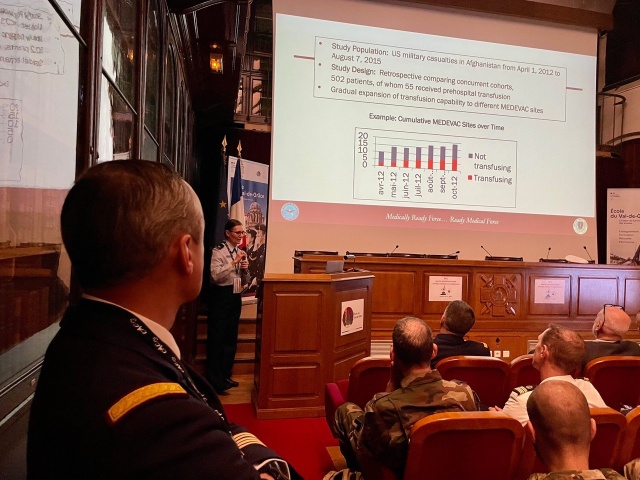
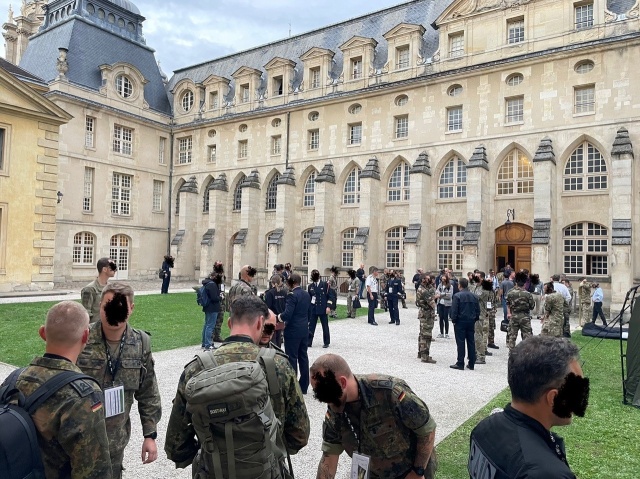
References
- Shackelford SA, Remley MA, Keenan S, Kotwal RS, Baker JB, Gurney J, Rush S, Friedrichs P. Evidence-based principles of time, triage and treatment: Refining the initial medical response to massive casualty incidents. J Trauma Acute Care Surg 2022;93(2S Suppl 1):S160-S164.
- Martinaud C, Travers S, Pasquier P, Sailliol A, Ausset S. Blood far forward program: Update on French armed forces policy. Transfusion 2021;61 Suppl 1:S354-S355.
- Cap AP, Polk TM, Cannon JW. Charting a new path after two decades of war and a global pandemic. J Trauma Acute Care Surg 2021;91(2S Suppl 2):S1-S5.
- Hodgetts TJ. The future character of military medicine. J R Army Med Corps 2012;158(3):271-8.
- Thompson P, Hudson AJ, Convertino VA, Bjerkvig C, Eliassen HS, Eastridge BJ, Irvine-Smith T, Braverman MA, Hellander S, Jenkins DH, Rappold JF, Gurney JM, Glassberg E, Cap AP, Aussett S, Apelseth TO, Williams S, Ward KR, Shackelford SA, Stroberg P, Vikeness BH, Pepe PE, Winckler CJ, Woolley T, Enbuske S, De Pasquale M, Boffard KD, Austlid I, Fosse TK, Asbjornsen H, Spinella PC, Strandenes G. Risk of Harm Associated With Using Rapid Sequence Induction Intubation and Positive Pressure Ventilation in Patients With Hemorrhagic Shock. J Spec Oper Med 2020;20(3):97-102.
- Morvan JB, Cotte J, des Deserts MD, Worlton T, Menini W, Cathelinaud O, Pasquier P. Operational Consideration for Definitive Airway Management in the Austere Setting: A Case Report. J Spec Oper Med 2022;22(3):90-93.
- Fisher AD, DesRosiers TT, Papalski W, Remley MA, Schauer SG, April MD, Blackman V, Brown J, Butler FK Jr, Cunningham CW, Gurney JM, Holcomb JB, Montgomery HR, Morgan MM, Motov SM, Shackelford SA, Sprunger T, Drew B. Analgesia and Sedation for Tactical Combat Casualty Care: TCCC Proposed Change 21-02. J Spec Oper Med 2022;22(2):154-165.
- Corcostegui SP, Commeau D, Galant J, Ramon F, Boutillier du Retail C. Intranasal sufentanil given in the emergency department triage zone for severe acute traumatic pain-a randomized double-blind controlled trail: comment. Intern Emerg Med 2019;14(4):635-636.
- Montagnon R, Cungi PJ, Aoun O, Morand G, Desmottes J, Pasquier P, Travers S, Aigle L, Dubecq C. Use of intranasal analgesia in French armed forces: a cross sectional survey. J Spec Oper Med [accepted for publication on November 2022].
- Malgras B, Aoun O, Pauleau G, Boddaert G, Hornez E, Dulou R, Delmas JM, Haen P, Laversanne S, Crambert A, Balandraud P. Deployment of the Surgical Life-saving Module (SLM) in 2017: Lessons learned in setting up and training operational surgical units. Injury 2019;50(5):1133-1137.
- de Schoutheete JC, Hachimi Idrissi S, Watelet JB. Pre-hospital interventions: introduction to life support systems. B-ENT 2016;Suppl 26(1):41-54.
- https://sfar.org/facteurs-humains-en-situations-critiques/ Last Accessed December 8, 2022.
- https://www.power-strategy.com Last Accessed December 8, 2022.
- Levy F, Rautureau G, Jouvent R. La terapia por realidad virtual en el tratamiento de los trastornos de ansiedad [Virtual reality therapy in the care management of anxiety disorders]. Vertex 2018;29(137):51-54.
- Morand G, Haar A, Travers S, Aigle L, Dubecq C, The medical constraints of high altitude for the military parachutist at very great height. International review of the Armed Forces Medical Services 2021;94(3):48-60.
- https://www.wsj.com/articles/treating-ukraine-wounded-civilians-horror-and-hope-kharkiv-war-russia-missile-strike-civilian-target-death-injury-syria-trauma-11652037327#comments_sector Last Accessed December 8, 2022.
- Webster S, Barnard EBG, Smith JE, Marsden MER, Wright C. Killed in action (KIA): an analysis of military personnel who died of their injuries before reaching a definitive medical treatment facility in Afghanistan (2004-2014). BMJ Mil Health 2021;167(2):84-88.
- Macku D, Hedvicak P, Quinn JM, Bencko V. Prehospital Medicine and the Future Will ECMO Ever Play a Role? J Spec Oper Med 2018;18(1):133-138.
- Corcostegui SP, David M, Galant J, Martinaud C, Travers S, Boutillier du Retail C. Prehospital blood transfusion: Advances and interests in tactical medicine. Anaesth Crit Care Pain Med 2021;40(4):100911.
- Thabouillot O, Boddaert G, Travers S, Dubecq C, Derkenne C, Kedzierewicz R, Bertho K, Prunet B. Effectiveness of Short Training in Resuscitative Endovascular Balloon Occlusion of the Aorta (REBOA) by Emergency Physicians: The Applied Course for Internal Aortic Clamping on Field Mission. J Spec Oper Med 2021;21(3):36-40.
- Daniel Y, Conort S, Foricher R, Hejl C, Travers S, Foissaud V, Martinaud C. Evaluation of hemostatic capacities among commando candidates: Would their blood suit a hemorrhagic war-injured patient in case of blood donation on the battlefield? J Trauma Acute Care Surg 2021;91(4):672-680.
- Hornez E, Gonzalez F, Rigal S, Bonnet S. Maintaining clinical competencies of military surgeons at the beginning of the 21st century: the French paradigm. J Trauma Acute Care Surg 2017;83(3):562-563.
- Ponsin P, Swiech A, Poyat C, Alves F, Jacques AE, Franchin M, Raynaud L, Boutonnet M. Strategic air medical evacuation of critically ill patients involving an intensive care physician: A retrospective analysis of 16 years of mission data. Injury 2021;52(5):1176-1182.
- Gasc T. État des Lieux des connaissances et des pratiques des médecins des forces concernant La Prise en charge du Coup de Chaleur d'exercice (CCE) à la phase aiguë. Sciences du Vivant [q-bio]. 2021. dumas-03270955 [thesis].
- McEvoy CB, Crabtree A, Powell JR, Meabon JS, Mihalik JP. Cumulative Blast Exposure Estimate Model for Special Operations Forces Combat Soldiers. J Neurotrauma 2022 [Epub ahead of print].
- de Mello WF, Greenwood NP. The burns fluid grid. A pre-hospital guide to fluid resuscitation in burns. J R Army Med Corps 2009;155(1):27-9.
- Giaume L, Daniel Y, Calamai F, Derkenne C, Kedzierewicz R, Demeny A, Bertho K, Travers S, Prunet B, Dorandeu F. "I AM THOR/DUST DAHO": mnemonic devices used by the Paris Fire Brigade to teach initial measures in undertaking a CBRN event. Crit Care 2021;25(1):116.
- Dubecq C, Dubourg O, Morand G, Montagnon R, Travers S, Mahe P. Point-of-care ultrasound for treatment and triage in austere military environments. J Trauma Acute Care Surg 2021;91(2S Suppl 2):S124-S129.
- Remley MA, Loos PE, Riesberg JC. Prolonged Casualty Care Guidelines 21 December 2021. J Spec Oper Med 2022;22(1):18-47.
- http://www.cmc-conference.de/index.php?translate=1 Last Accessed December 8, 2022.
Figures
Figure 1: École du Val-de-Grâce, French military medical academy.
Figure 2: scientific leaders of the conference.
Figure 3: Attendees at the Paris SOF-CMC Conference, École du Val-de-Grâce.
Figure 4: 32 nations at the Paris SOF-CMC Conference.
Figure 5: COL Stacy Shackelford (USA) Chief Joint Trauma System Defense Center of Excellence for Trauma in the main conference hall.
Figure 6: Workshops, e.g Stop the bleed. SAM MEDICALÔ
Figure 7: Exhibition in the square of the École du Val-de-Grâce.
Date: 12/19/2022











